On 27 May 1967, Australians voted in record numbers to alter two sections of the Constitution so it no longer discriminated against Aboriginal people. The landslide ‘yes’ vote was seen as a watershed moment in relations between Indigenous and non-Indigenous Australians.
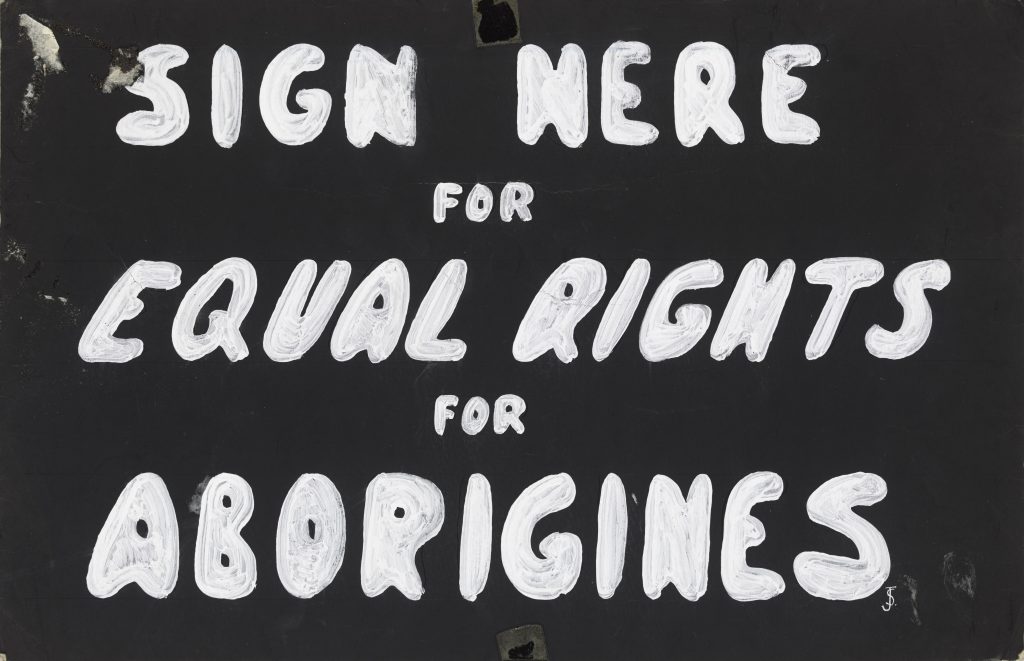 Sign here for equal rights for Aborigines. From Records of the Council for Aboriginal Rights (Vic.), 1951-1975. This work is in copyright.
Sign here for equal rights for Aborigines. From Records of the Council for Aboriginal Rights (Vic.), 1951-1975. This work is in copyright.
Over the years, mythology around the event has grown. Many still believe the referendum delivered citizenship rights to Indigenous Australians, and the right to vote. In reality, the referendum did no such thing. So what, exactly, was at stake?
Some background
The 1967 referendum had been a long time coming. As far back as 1913, a committee on Aboriginal welfare established by the Australasian Association for the Advancement of Science, suggested that ‘this unfortunate race whom we have dispossessed’ should be made ‘a single and National responsibility and cared for in a National way’. [1]
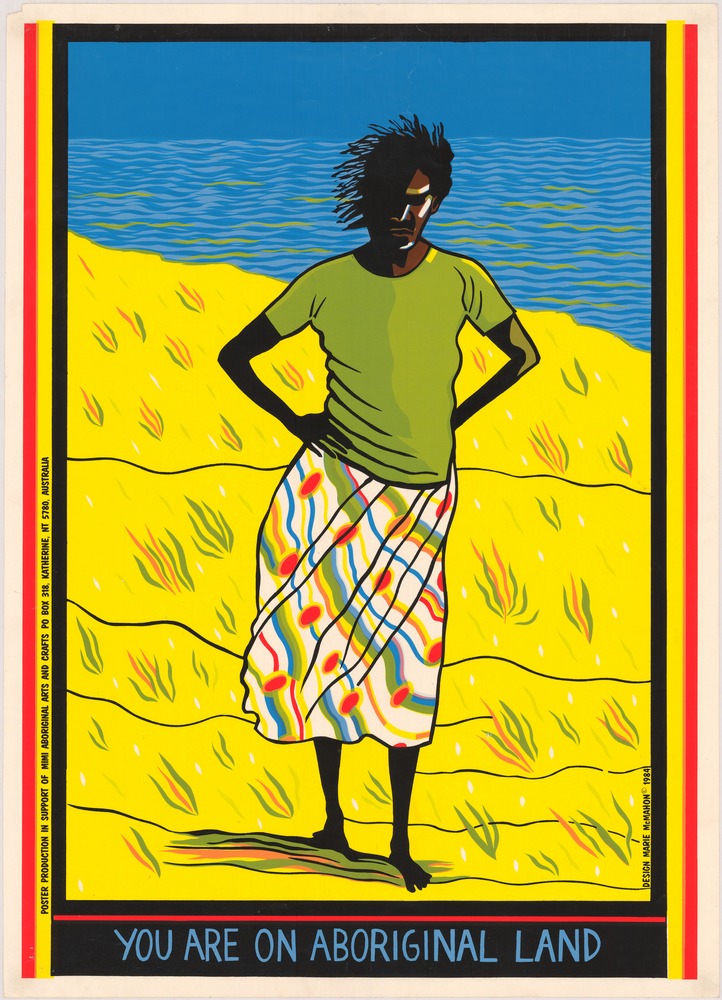 You are on Aboriginal land. From Riley & Ephemera poster collection. This work is in copyright.
You are on Aboriginal land. From Riley & Ephemera poster collection. This work is in copyright.
In 1938, the Australian Aborigines League and the Aborigines Progressive Association announced a ‘day of mourning’ to coincide with Australia’s 150th anniversary celebrations:
‘That we, representing the Aborigines of Australia … make protest against the callous treatment by the white men during the 150 years past, and we appeal to the Australian nation of today to make new laws for the education and care of Aborigines, and we ask for a new policy which will raise our people to full citizen status and equality within the community.'[2]
 The Age, 19 August 1944, p. 3
The Age, 19 August 1944, p. 3
In 1944, the Curtin government sought the power to legislate on a range of different issues, including Indigenous affairs, with its ’14 powers’ referendum (Post-War Reconstruction and Democratic Rights). The referendum failed to carry. However, there were suggestions it was fatally flawed, as the 14 proposals: ‘good, bad, and indifferent’, had all been lumped together in a single question (South-Western News, 17 August 1944, p 2).
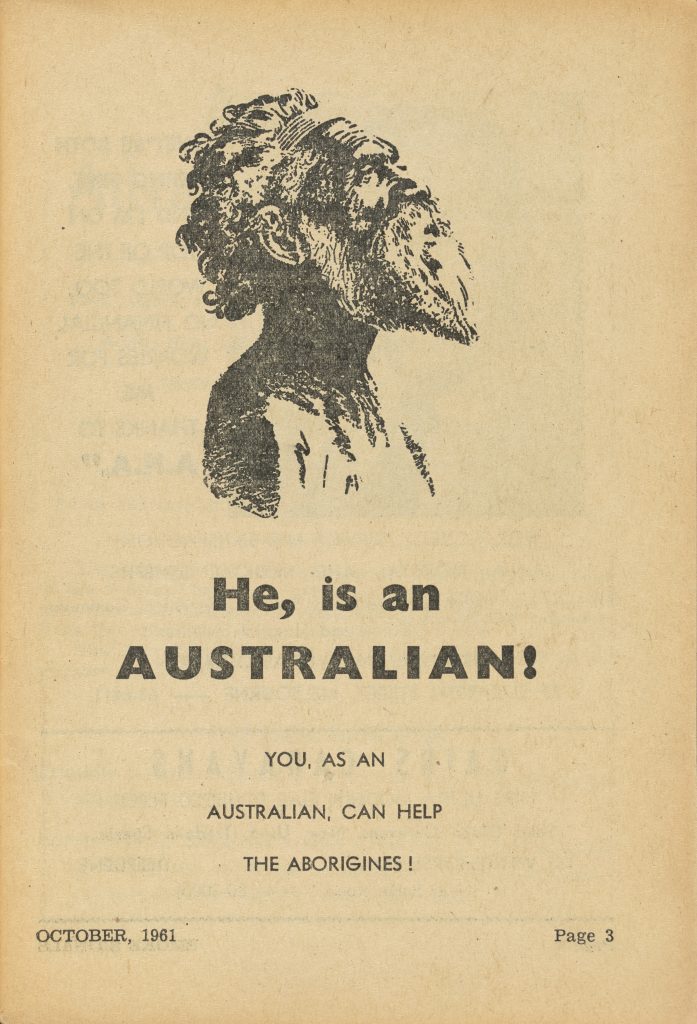 He, is an Australian. From Smoke Signals, October, 1961. This work is in copyright.
He, is an Australian. From Smoke Signals, October, 1961. This work is in copyright.
Despite the defeat of the Curtin government’s referendum, limited progress towards Aboriginal rights continued to be made. Aboriginal organisations, including the Aborigines Progressive Association and the Australian Aborigines’ League, lobbied persistently for change. In 1949, the Commonwealth amended the Commonwealth Electoral Act, so that Aboriginal ex-servicemen were eligible to vote. In 1962, the Commonwealth went further, passing legislation to give all Aboriginal adults the right to vote in federal elections.
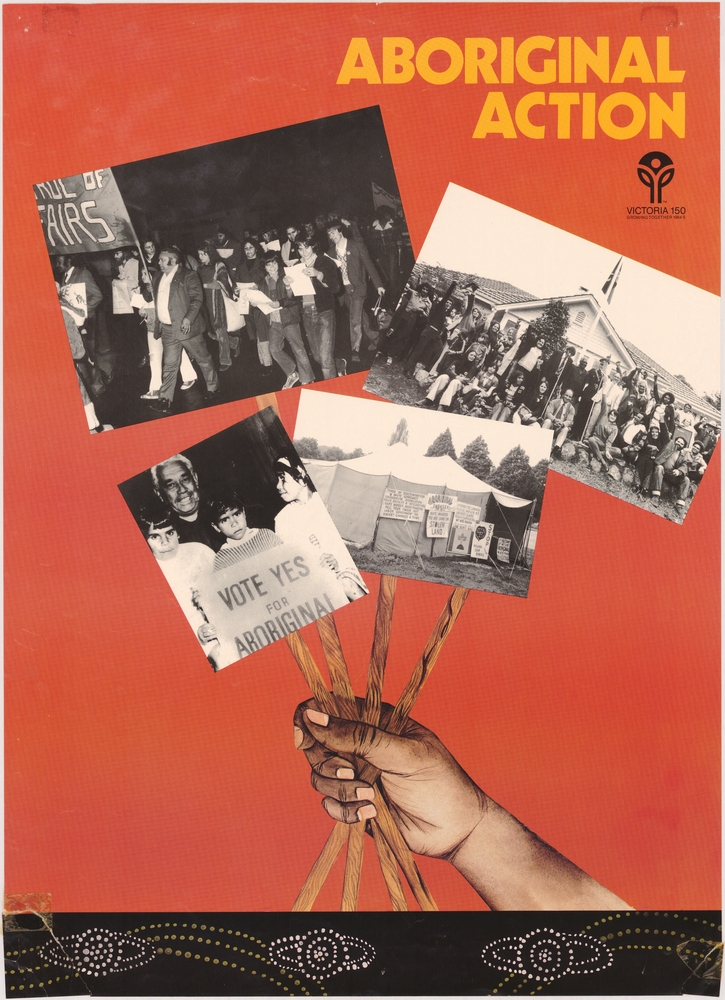 Aboriginal action. From Riley & Ephemera poster collection. This work is in copyright.
Aboriginal action. From Riley & Ephemera poster collection. This work is in copyright.
Despite these small victories, Aboriginal Australians continued to be disempowered. Deprived of their traditional land and culture, many lived in extreme poverty, with poor health and educational outcomes, little prospect of employment, and no hope for the future.
In 1958, a new player emerged on the political landscape. The Federal Council for Aboriginal Advancement called for equal rights for Aboriginal people. They also argued that the Commonwealth government should assume responsibility for Aboriginal affairs. According to the Council, there was only one way for these things to be achieved: the Australian Constitution needed to be changed.
 Public meeting notice: the launch of a national petition for a federal referendum. From Records of the Council for Aboriginal Rights (Vic.), 1951-1975. This work is in copyright.
Public meeting notice: the launch of a national petition for a federal referendum. From Records of the Council for Aboriginal Rights (Vic.), 1951-1975. This work is in copyright.
The campaign for a referendum was launched by the Council in October 1962, but it was not until 1967 that it came to fruition.
The referendum
The referendum would address two sections of the Constitution: Section 51(xvii) – which provided that the federal government could pass special laws for all races of people in Australia ‘other than the Aboriginal people’; and Section 127, which stated that if a census was taken of Commonwealth or state populations, ‘Aboriginal people should not be counted’.
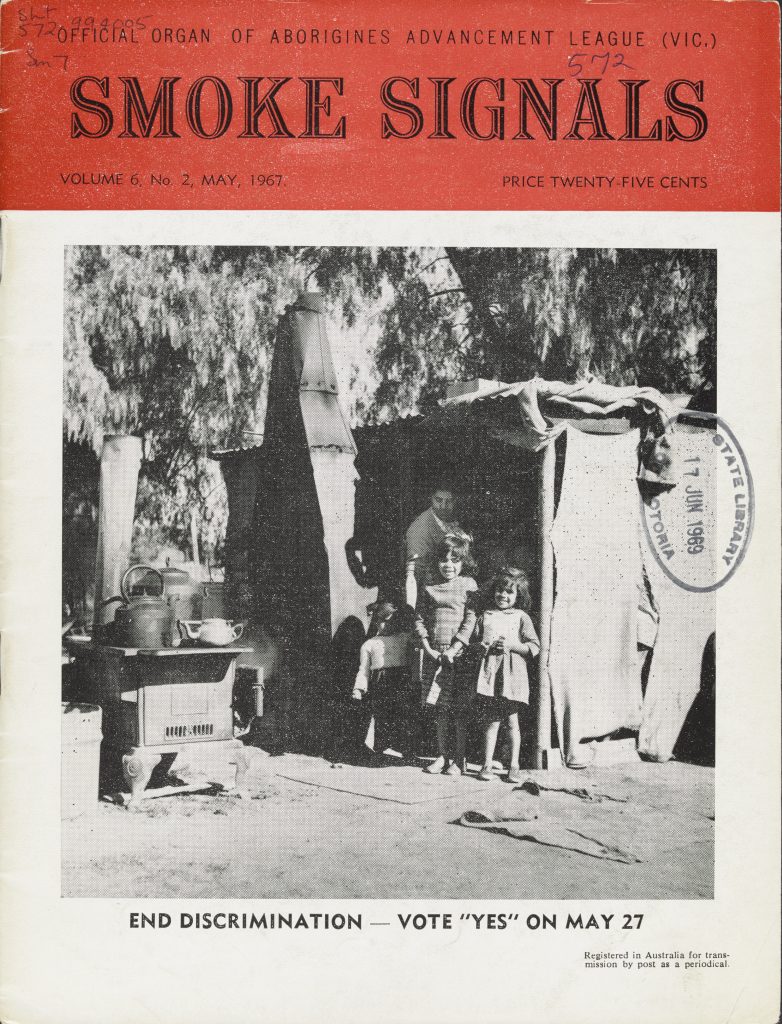 End discrimination. Vote ‘yes’ on May 27. Smoke Signals, May, 1967. This work is in copyright.
End discrimination. Vote ‘yes’ on May 27. Smoke Signals, May, 1967. This work is in copyright.
The Federal Council embarked on an emotional campaign to win the Australian people over: ‘a call to the nation’ to ‘stir the people’s hearts and minds’ (Age, 25 March 1967). It alleged that a ‘Yes’ vote would give Aboriginal people equality in the form of citizenship rights. It would also enable the Commonwealth to assume responsibility for Indigenous affairs, so that they could embark on major programs to reduce Aboriginal disadvantage.
The publicity campaign was highly successful. It used evocative images of Aboriginal children to symbolise a new start for Aboriginal people. Leaflets were distributed urging the public to: ‘Right wrongs: vote yes for Aborigines on May 27’.
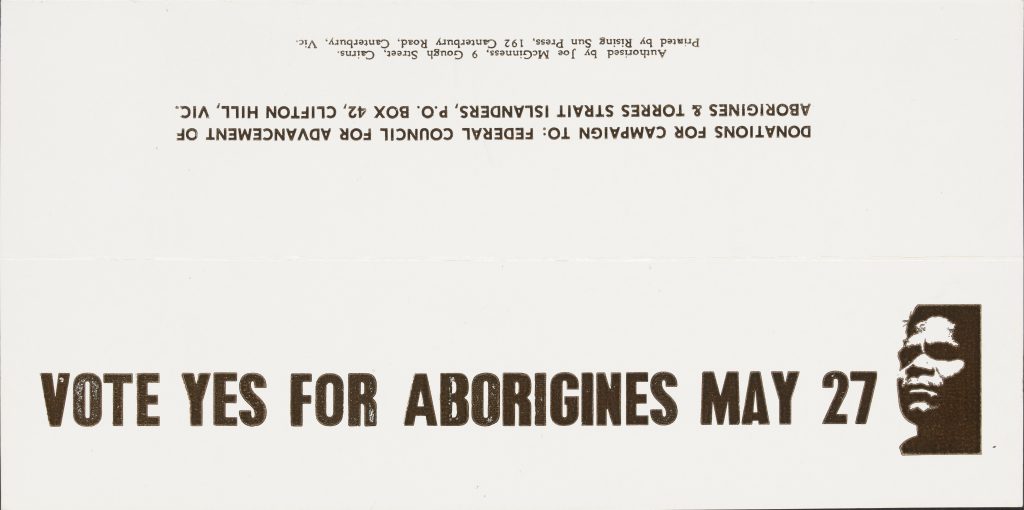 Vote yes for Aborigines May 27. From Records of the Council for Aboriginal Rights (Vic.), 1951-1975. This work is in copyright.
Vote yes for Aborigines May 27. From Records of the Council for Aboriginal Rights (Vic.), 1951-1975. This work is in copyright.
Despite the absence of a ‘No’ campaign, the task before the Federal Council was daunting. Only four of the previous 24 constitutional referenda held in Australia had been successful. The council didn’t just need a win. It needed a huge ‘Yes’ result to force the federal government to take decisive action for change.
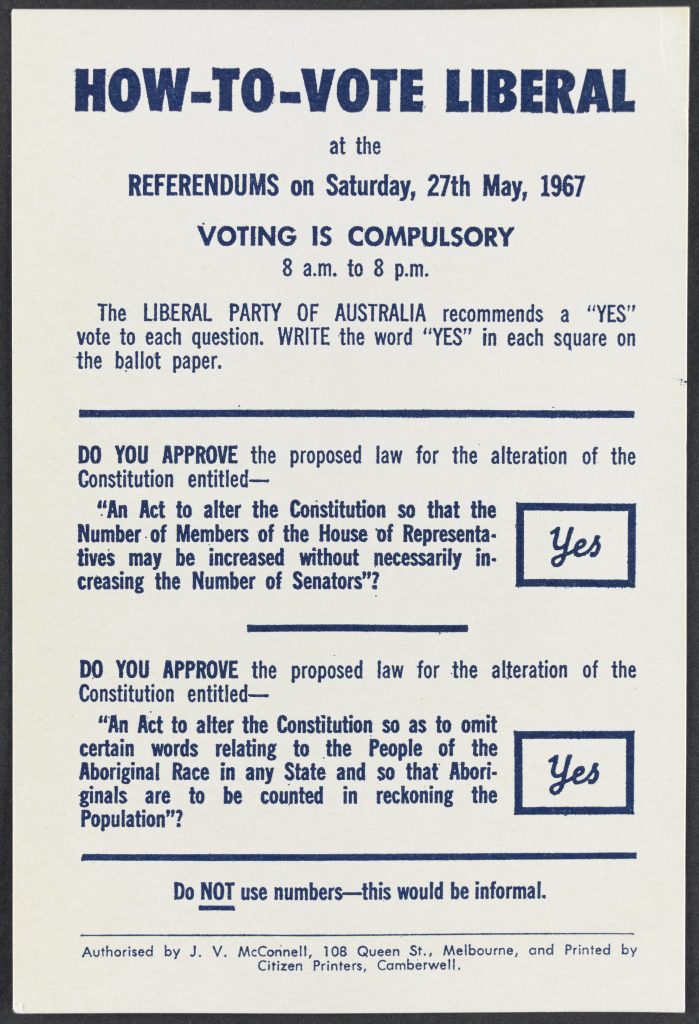
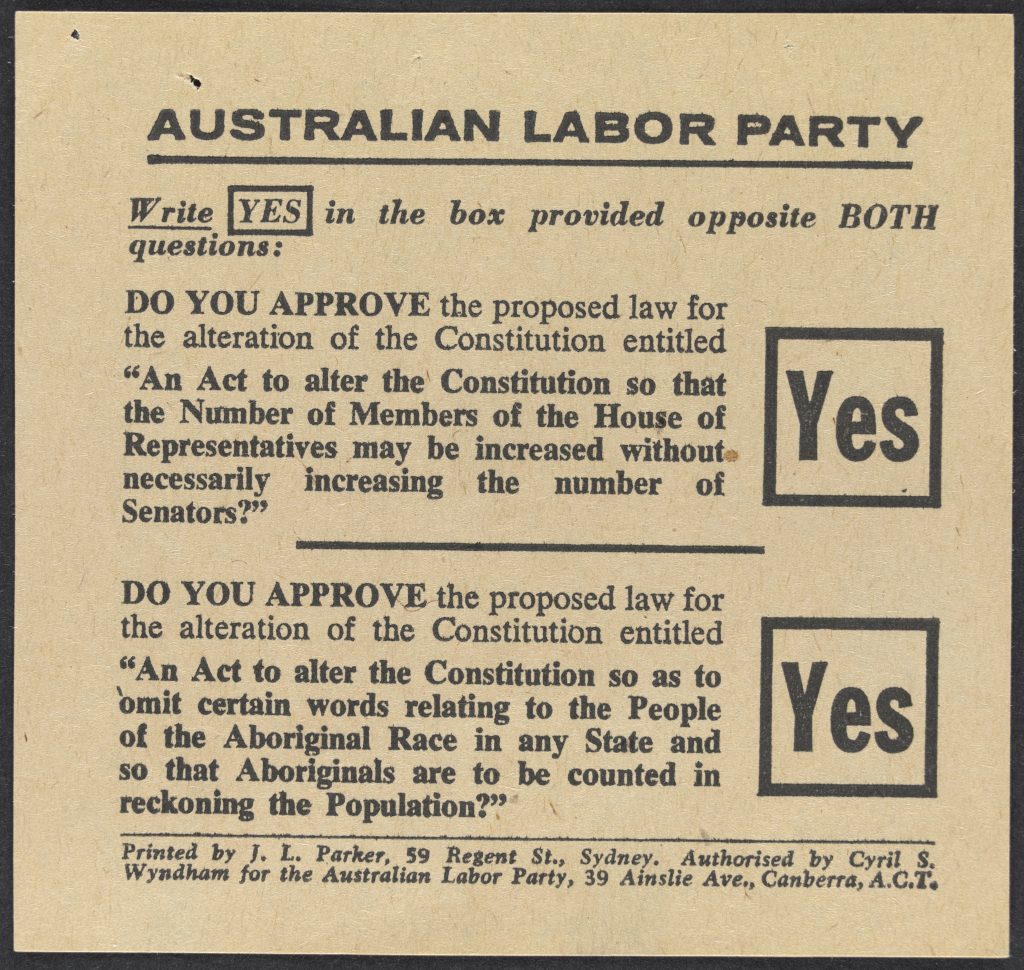
‘How to vote’ cards from the 1967 referendum. Riley & Ephemera collection.
The nation held its breath as the votes were counted. By the following morning, the results were in. A resounding 90.77 per cent of people had voted ‘Yes’. It was the strongest ‘Yes’ result in Australian political history.
Righting the Wrongs
Fifty years later, the 1967 referendum remains a milestone in Australian political history. On a symbolic level, it was hugely significant. It did, however, have one unintended consequence …
Now the Australian Constitution fails to acknowledge Indigenous Australians at all.
 White Australia has a black history – Don’t Celebrate 1988. This work is in copyright.
White Australia has a black history – Don’t Celebrate 1988. This work is in copyright.
Postscript
You can read more about the 1967 referendum campaign and results at the website Right Wrongs, a joint project of the ABC, National and State Libraries Australasia, and Australian Institute of Aboriginal and Torres Strait Islander Studies.
Currently, a Referendum to recognise Aboriginal people in the Constitution is being considered, but there is an opposing Aboriginal grass roots campaign for a Treaty too. All parties will be meeting at Uluru very soon to discuss outcomes and ongoing action – Maxine Briggs, Koorie Librarian, Collection Development & Discovery Division
References
[1] Bain Attwood & Andrew Markus, The 1967 Referendum: Race, Power and the Australian Constitution, p. 7. Also available as an ebook for Victorian Access members.
[2] Aboriginal Progressive Association, 1938, Australian Aborigines Conference : sesqui-centenary Day of Mourning and Protest to be held in the Australian Hall, Sydney … on Wednesday, 26th January 1938 (Australia Day) … : Aborigines and persons of Aboriginal blood only are invited to attend


I am ashamed to say I did not realise that the constitution actually discriminated so blatantly against the aboriginal people – the clauses S.51 and S.127 were shameful!
Thankfully the 1967 referendum was a real breakthrough – a 90% ‘yes’ vote was absolutely remarkable.
I do hope this latest referendum proposal is carried with the same spirit.
Thank you for such an insightful piece Sarah
I did not realise that the unintended consequence of the referendum was to wipe mention of the original Australians from the constitution. When are we going to get it right ? A lot of expensively trained constitutional lawyers could surely work out something fair to all, but particularly to the custodians of this land , for thousands of years. As an immigrant I am so grateful I was welcomed here, but I was so ignorant of the struggles of the aboriginals( I hope that is not an offensive name). I hope they get the recognition they have long deserved.